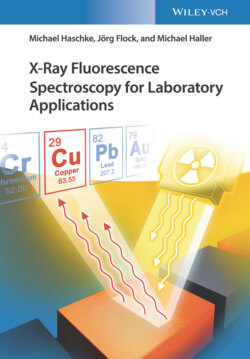Читать книгу X-Ray Fluorescence Spectroscopy for Laboratory Applications - Michael Haschke, Jörg Flock - Страница 19
2.2.5 Detection of X-ray Spectra
ОглавлениеThe radiation emitted by a sample is detected by an X-ray spectrometer. The spectrometer separates energetically different beam components and determines their intensity within narrow energy ranges; they can be, for example, individual element peaks as well as background areas with narrow energy ranges of a few electronvolts. In principle, two instrument types for spectrometry are in use where the dispersion takes place by different means:
In the case of wavelength-dispersive spectrometers (WDSs – see Section 4.3.2), the separation of the radiation components takes place via a dispersive element, for example, a crystal, or, at low energies, by special multilayer structures, on which the fluorescence radiation of the sample is diffracted. The “reflection” of individual energies takes place only at defined diffraction angles, following Bragg's law, see Eq. (4.1).
In the case of energy-dispersive spectrometers (EDSs – see Section 4.3.1.3), the dispersion is performed directly in the detector and its associated electronics. This generates an energy-dependent signal from each individual absorbed X-ray photon. By means of pulse-height analysis, the probability distribution of the photon energies absorbed in the detector can be generated, creating an image of the emitted spectrum.
For analytical purposes, element identification, i.e. qualitative analysis, is possible due to the element dependence of the energies of the characteristic radiation (see Eq. (2.4)).
The intensity of this characteristic radiation depends on the number of atoms in the analyzed material, i.e. on their contents w. In a first approximation, therefore, the mass fraction w = ε·I, where ε is the element-dependent sensitivity, and I is the measured fluorescence intensity of the element under consideration. Unfortunately, the conditions are more complex than this, as all other elements in the sample influence through absorption and secondary excitation the measured fluorescence intensities. For a quantitative analysis this matrix influence has to be considered. It leads to complex corrections of the above linear dependency (see Section 5.5).
